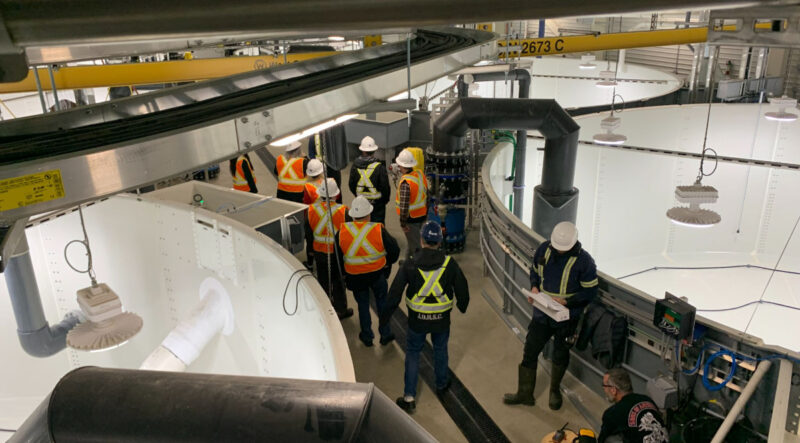Another smolt step in Grieg’s aquaculture transition plan
Grieg Seafood’s hatchery expansion project will allow juvenile salmon to grow longer on land before being transferred to sea farms in British Columbia
By SeaWestNews
Grieg Seafood BC has received the first transfers of juvenile Atlantic salmon into its expanded hatchery facility on Vancouver Island, marking a milestone in the company’s journey to transition more of its production to land-based facilities.
The expansion of Grieg’s Gold River Hatchery, known as RAS 34, was successfully completed earlier this spring.
Smolts or juvenile salmon from this facility will be used to stock Grieg’s 22 farms in BC, after spending longer periods on land before being transferred to sea pens.
“In total, the project represents an investment of $25 million and the creation of almost 60 fulltime site positions at the peak of construction,” said Rocky Boschman, Managing Director for Grieg Seafood BC.
“The new facility will effectively double our smolt capacity at our hatchery and the new technology will allow us to start to explore keeping our fish in the hatchery for longer, reducing the amount of time required in the ocean, known as post-smolt farming or production,” he said.
Traditionally, smolts have been transferred to sea at about 100 grams in weight. In post-smolt production, the fish are held back in the hatchery for an additional period of time, allowing the fish to grow to anywhere from 200 grams up to a kilogram, before being transferred to the ocean. This doesn’t have any negative effects on the salmon, but rather is being shown to produce benefits from both wild and farmed populations.
“The larger smolts are better able to adapt to the transfer to ocean conditions, have less mortality overall, and show higher resistance to naturally occurring pathogens and parasites in the ocean,” said Scott Peterson, Freshwater Director with Grieg Seafood BC.
“Depending on how large the fish are when they are transferred, the time spent in the ocean can be reduced by up to a year, greatly minimizing interactions with wild populations,” he said.
“As we become more comfortable with the technology, we will look to incorporate additional size trials into our production schedule. This is part of our overall company goal of transitioning more of our production onto land.”
Grieg is also in the process of deploying semi-closed barrier systems at three of its farms in Esperanza Inlet, on the west coast of Vancouver Island, which reduces the interaction between wild and farmed salmon populations.
Grieg is one of the largest salmon farming companies in BC and is targeting 22,000 metric tonnes of harvest in 2022. It is headquartered in Campbell River, BC and has approximately 180 fulltime employees, mainly located in the rural coastal communities in which it operates.
RAS 34 Project Quick Facts:
- Total project cost: $24.75 million.
- Project related job creation: At the peak of construction, 57 full-time jobs were created by the project.
- Most project contractors, project workers, and materials were sourced locally on Vancouver Island.
- Construction timeline: approximately three years, 2019 – 2022 (this included a three-month project shut down during Covid-19 pandemic).
- Capacity of the new facility: up to 400 metric tonnes of fish.
- Capacity of original facility: 500 metric tonnes.
- Combined capacity of expanded facility 900 metric tonnes.
- Largest size smolt which can be grown in the new facility: up to one kilogram
(Image: Grieg’s expanded Gold River Hatchery, known as RAS 34, was successfully completed earlier this spring)

